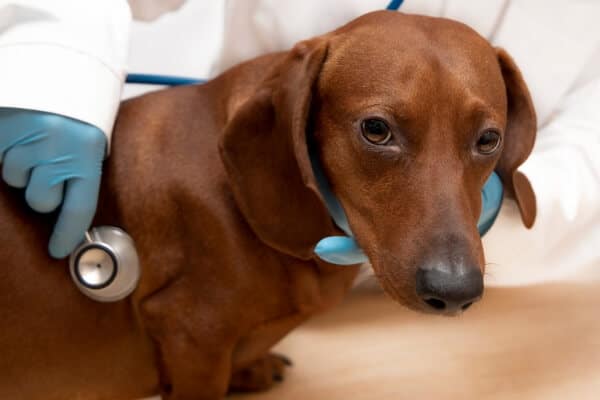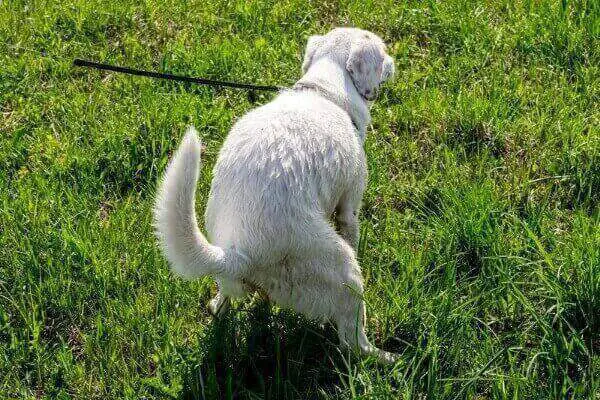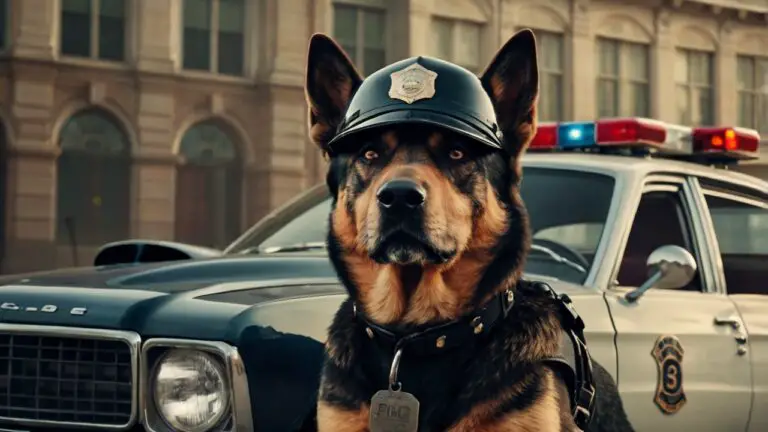Can Dogs Get Pregnant While Bleeding Or Not In Heat?

Female dogs, unlike the males, have specific periods of fertility known as heat or estrus . These cycles, which typically start when a dog reaches sexual maturity at six to nine months of age (or later for larger breeds), involve several stages and observable signs. One common sign is bleeding, which often raises questions about whether dogs can get pregnant while bleeding.
The estrus stage of a dog’s heat cycle is when the female dog is receptive to mating and can become pregnant by doing so but the bleeding has stopped by this time. It is during the proestrus stage, which precedes the estrus, that dogs produce a bloody vaginal discharge. However, the likelihood of conception during this phase is very low.
It is important to wait for the right time to breed your dog or just allow dogs to naturally decide when they breed because canines have been successfully mating before human intervention. However, the knowledge of the reproductive cycle of your dog is crucial, whether you’re considering breeding or seeking to avoid an unplanned pregnancy.
Read Also: Can Dogs Get Pregnant While Nursing? (Explained!)
Jump to Section
Can Dogs Get Pregnant While Bleeding?
While the chance is not zero, the probability of a dog getting pregnant while bleeding—which typically occurs in the proestrus stage of a dog’s heat cycle, is extremely low. The main reason is that ovulation – the release of eggs from the ovaries for fertilization – typically does not occur until the next phase, known as estrus. During estrus, the bloody discharge often turns into a straw-colored fluid, and this is the period when the dog is most fertile and receptive to mating.
However, heat cycles can vary greatly among individual dogs. In some cases, a dog might ovulate early, towards the end of the proestrus stage. This means that while the likelihood is low, it is technically possible for a dog to become pregnant if she mates during late proestrus.
Proestrus typically lasts between 9-10 days, during which you may notice several signs indicating that your dog has entered this phase. A swollen vulva and bloody vaginal discharge are the most obvious physical signs, but you may also observe behavioral changes, like an increased level of alertness or anxiety, due to hormonal fluctuations.
It’s important to understand that during proestrus, your dog’s body is preparing for a potential pregnancy. However, while she might attract male dogs due to her scent, she is not yet fertile and is generally unwilling to mate. Male dogs may try to mount her during this phase, but she will often reject their advances, indicating that she’s not yet ready to conceive.
That said, it’s essential to monitor your dog closely and consult with a vet if you have any concerns or if you’re planning to breed. If preventing pregnancy is your goal, consider spaying or using other methods of contraception recommended by your vet to eliminate the risk of unplanned pregnancies.
When Can A Dog Get Pregnant During Her Heat Cycle?
Dogs can get pregnant during the estrus phase of their heat cycle. It’s during this period that ovulation occurs – the release of mature eggs from her ovaries. The eggs then travel down to the uterus, where they can be fertilized by sperm. This is also the period when a female dog is most receptive to a male dog’s advances.
The estrus phase may last for up to 2 weeks and may be longer or shorter depending on the breed. You would often notice that vaginal bleeding subsides and the discharge becomes lighter or pinkish. This is coupled with vulvar swelling.
For breeders trying to determine the ideal time for mating, several tests can be done. Vaginal cytology can be used to examine the cellular changes in the vaginal discharge, indicating the stage of the heat cycle. Hormone tests can also be done to determine the rise in luteinizing hormone (LH) which usually corresponds with ovulation.
For pet owners wishing to avoid unwanted pregnancy, it’s safest to assume that a dog can become pregnant at any point during her heat cycle and to take appropriate precautions. These may include isolating her from male dogs, using doggie diapers to prevent messes and attraction of male dogs, or considering spaying if you do not plan to breed your dog.
Can Dogs Get Pregnant While Not In Heat?
When it comes to a dog’s fertility and reproductive cycles, it’s essential to understand that, unlike humans, dogs do not have a menstrual cycle that allows for potential pregnancy throughout the year. Instead, dogs have distinct cycles known as heat cycles. As such, a dog’s ability to conceive is closely tied to these cycles.
Heat cycles, or estrus cycles, occur approximately every six months on average and are divided into four distinct stages: proestrus, estrus, diestrus, and anestrus. The primary fertility window for a female dog, when she can become pregnant, is during the estrus stage of this cycle.
Dogs can only become pregnant when they are in heat, specifically during the estrus phase of the cycle. However, there have been cases where dogs may get pregnant at the end of the proestrus but the chance of this happening is relatively low.
Normally, during the proestrus or diestrus stages of the heat cycle, a dog is highly unlikely to become pregnant. Although the dog starts attracting males in the proestrus stage, her body is not yet ready for pregnancy. The diestrus phase follows estrus and further conception during diestrus is not possible but sometimes a dog may already be pregnant from mating during estrus.
During anestrus, the final stage of the dog’s heat cycle, the reproductive tract is in a resting phase. The anestrus stage can last anywhere from 2 to 4 months, during which the dog’s body takes a break and prepares for the next heat cycle. During this stage, and indeed at any point outside of the estrus phase, dogs cannot conceive because ovulation does not occur —of course, except for rare cases at the end of the proestrus phase.
How Does Dog Heat Cycle Work?
The dog’s heat cycle typically happens twice a year for most breeds, but the frequency can vary depending on the breed and individual dog’s health. The heat cycle consists of four stages: proestrus, estrus, diestrus, and anestrus.
1. Proestrus
Proestrus marks the beginning of the heat cycle. During this period, the female dog’s body is preparing for potential pregnancy, although she’s not yet receptive to mating. The ovaries start to release follicles that produce estrogen, causing the uterus to thicken and prepare for possible embryo implantation.
The most apparent physical signs during this phase include a swollen vulva and vaginal bleeding. On a hormonal level, estrogen levels peak and then sharply decline towards the end of proestrus. Despite attracting male dogs due to the pheromones she’s releasing, the female will usually reject their advances. This phase generally lasts 7-10 days, but it can extend up to 20 days in some cases.
2. Estrus
The Estrus stage is when the female dog becomes receptive to mating, and it is the period during which she is most fertile and can conceive. She’s said to be in heat or season during this period. This phase happens when estrogen levels drop and progesterone levels rise, signaling that the female is ready for ovulation.
The bloody discharge that was a marker of proestrus will typically lighten to a pinkish or straw color, although it can occasionally be clear. Her vulva remains enlarged, and she may demonstrate a ‘flagging’ behavior, where she raises her tail to the side, indicating her willingness to mate with a male dog. This stage can last anywhere between 5-14 days.
3. Diestrus
Diestrus is the phase following Estrus and lasts for about 60-90 days. At this point, whether fertilization occurred or not, the female’s body behaves as if it is pregnant due to the dominance of progesterone. The lining of the uterus develops to either nourish the developing embryos or get reabsorbed if no pregnancy occurs.
Physically, the dog’s vulva will start to reduce in size, and the discharge will cease. If pregnant, other signs will start to appear, like weight gain, increased appetite, and behavioral changes. If not, she will gradually return to her usual self.
4. Anestrus
Anestrus is the resting stage, where the female dog’s body recovers and prepares for the next cycle. Lasting between 2 to 4 months, this phase involves no overt hormonal activity, sexual behavior, or physical changes.
The complete heat cycle of a dog can range from 6 months to a year, depending on the breed and individual differences. Small breeds may cycle three times a year, while larger breeds might only cycle once every 12-18 months. During the first few cycles of a young dog, irregularities may occur, which usually resolve as the dog matures.
Always consult with your vet about any changes or concerns regarding your dog’s reproductive health. Understanding these stages and their signs is essential for responsible pet ownership, especially if you’re considering breeding your dog.
Signs That Your Dog Female Dog Is Ready To Mate
Recognizing the signs that your female dog is ready to mate is crucial for breeders or dog owners planning for a litter. It’s also equally important for those who want to avoid unexpected pregnancies. These signs appear during the estrus phase of a female dog’s heat cycle, which typically occurs twice a year. Here are some key signals to watch out for:
- Change in Behavior: As a female dog enters her heat cycle, you may observe behavioral changes. She may become more affectionate, and anxious, or display unusual behaviors, like being more alert or restless.
- Swelling of the Vulva: A noticeable swelling of the vulva is one of the earliest physical signs of a dog’s heat cycle, often occurring during the proestrus stage. However, the dog isn’t ready to mate until the estrus stage.
- Changes in Discharge: Initially, during proestrus, the female dog will have a bloody discharge. As she moves into estrus and becomes ready to mate, the color of the discharge often changes from bloody to a lighter straw or clear color.
- Tail Flagging: When a female dog is ready to mate, she may display a behavior known as ‘flagging’. This refers to the action of the dog lifting her tail base and moving it to one side, a clear invitation to potential mates.
- Increased Urination: During heat, a female dog may urinate more frequently. This behavior is used to spread pheromones, signaling to males that she is in heat.
- Reception to Males: When a female dog is ready to mate, she will become more receptive to males. If a male dog is present, she may present herself to him by standing still and raising her rear when the male sniffs her.
- Increased Agitation: Some female dogs may show an increased level of agitation when they are ready to mate. This can include pacing, whining, or appearing to be overly alert.
- Loss of Appetite: Some dogs may also experience a temporary loss of appetite during their heat cycle.
How Do You Know If Dog Mating Is Successful?
The most reliable way to determine if mating has been successful is through veterinary tests. A vet can perform a manual examination after 28 days, although this should be done by an experienced professional to avoid risks to the embryos. Non-invasive tests like ultrasound can detect a pregnancy as early as 21-28 days post-breeding. A blood test can be done about a month after breeding to check for the presence of the hormone relaxin, which is only produced during pregnancy.
After about a month, you might notice physical changes if your dog is pregnant. Her abdomen will start to look noticeably larger as the puppies grow. Also, her nipples may become more prominent due to an increase in blood flow and preparation for lactation.
You can also get your hopes high if there was a tie after mating because it often comes with about a 40% chance of conception. However, this is not a necessity for successful mating and dogs can still get pregnant from a simple slip mating.
Can Dogs Mate When Bleeding?
When a female dog starts bleeding, it is usually a sign she is in the proestrus phase of her heat cycle. During this phase, which can last anywhere from a few days to two weeks, a female dog’s body is preparing for potential pregnancy, but she’s not typically ready to mate. Her discharge, often bloody, attracts males, but she’s usually not receptive to them yet.
A female dog in proestrus will not usually allow a male dog to mount her. She may show signs of disinterest or actively discourage a male’s attention by sitting, moving away, or even growling.
Only when she transitions into the estrus phase, the actual “heat,” will she be receptive to a male and ready for successful mating. During this time, her bleeding usually subsides, and her discharge changes to a lighter, straw-colored, or clear fluid.
Can A Dog Be In Heat And Not Bleed?
Yes, a dog can be in heat and not display noticeable signs of bleeding. This is commonly referred to as a “silent heat” or “quiet heat,” and it’s more common in young dogs experiencing their first few heat cycles, but can also occur in adult dogs.
The heat cycle in dogs, also known as estrus, is typically associated with various symptoms, including behavioral changes, increased urination, swelling of the vulva, and vaginal bleeding. The bleeding usually starts in the proestrus stage, the initial phase of the heat cycle, and generally decreases or changes color (becoming straw-colored or clear) when the dog moves into the estrus stage (the fertile period of her cycle).
However, not all dogs show these signs clearly, and some may not display any noticeable bleeding at all. This lack of visible signs can make silent heat challenging to detect, especially for inexperienced owners. In such cases, behavioral changes, such as increased interest from male dogs or changes in the dog’s behavior (more clingy, agitated, or displaying ‘flagging’ behavior, where the dog moves her tail to the side), may be the only clues.
The absence of visible bleeding doesn’t mean the dog is not in heat or cannot become pregnant. A dog in silent heat is just as capable of getting pregnant as a dog displaying typical signs of heat. Therefore, even if no bleeding is observed, it’s important to watch out for other signs of heat and to prevent contact with male dogs if you want to avoid pregnancy.
If you suspect your dog is having silent heat and you want to confirm this, a vet can perform tests such as blood tests to check hormone levels or cytological tests to examine cells in the vaginal discharge.
Can Puppies Get Pregnant Before Their First Heat?
Dogs, like all mammals, must go through a specific physiological process before they are capable of becoming pregnant. This process includes reaching sexual maturity and experiencing their first heat cycle. Therefore, puppies cannot become pregnant before their first heat.
In dogs, the first heat typically occurs between 6 to 9 months of age for smaller breeds, and in larger breeds, it can be as late as 18 months to 2 years old. However, these are just averages, and every dog is unique. It’s also important to note that the first heat can be relatively mild and go unnoticed, especially in smaller breeds.
During the first heat, or estrus cycle, a dog’s body undergoes hormonal changes, and her reproductive system matures, preparing her for potential conception and pregnancy. The heat cycle has four stages: proestrus, estrus, diestrus, and anestrus. The fertile period when a dog can become pregnant is during the estrus stage.
Even though a dog can technically become pregnant during her first heat, it is generally not recommended to allow puppies to breed at this young age. They are still growing and developing themselves and carrying a pregnancy to term and then caring for a litter can put undue stress on their still-developing bodies.
It’s also worth mentioning that responsible breeding involves more than just the capability of a dog to become pregnant. It should take into account the health and genetic history of both parents, the availability of good homes for potential puppies, and the ability of the owner to provide adequate care during pregnancy, whelping, and puppy-raising.
Final Thoughts
During the initial phase of proestrus, your dog experiences bleeding, but she will likely not get pregnant or even be open to mating. It’s in the subsequent estrus phase, when bleeding usually decreases or changes color, that your dog becomes receptive to males and is fertile.
It’s important to note that not all dogs will display typical signs of heat, such as visible bleeding. Silent heat, in which a dog goes through her heat cycle without obvious symptoms, can occur. In these instances, pregnancy is still a possibility, so owners must be vigilant and look out for other signs of heat.
Also, successful mating doesn’t guarantee a successful pregnancy, and the best way to confirm a successful mating has led to pregnancy is through veterinary confirmation, such as ultrasound or blood tests.
Ultimately, whether you’re planning to breed or aiming to prevent pregnancy, it’s crucial to consult with your vet or a professional breeder to ensure you’re making informed decisions that consider your dog’s overall health and well-being.
Read related posts about





